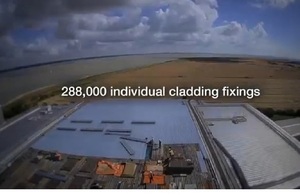New weather envelope completed at Bradwell, Essex
An aluminium weather envelope has been built around Bradwell’s two reactor structures in preparation for an 80 year care and maintenance period.

Aerial view of project to complete weather envelope at Bradwell site
The Bradwell nuclear site is close to the Essex coastline. Electricity generation started here in 1962 and ceased in 2002. During its lifetime the site generated nearly 60 TWh of electricity. The site is following an accelerated decommissioning programme and is now more than halfway through a programme of work which should see it become the first reactor site in the UK to enter Care and Maintenance.
The recent completion of this construction is the biggest transformation in Bradwell’s appearance since the power station was constructed in the 1950s.
More than 288,000 individual fittings have been used to build an aluminium weather envelope around the site’s two reactor structures.
Closure Director, Scott Raish, said:
Preparing for an 80 year care and maintenance period often means building things as well as demolishing them. This is the biggest construction project we will undertake and completing it safely is a huge step towards our end goal of closing this phase of decommissioning.
The project, which was undertaken in conjunction with contract partner Vinci Construction, has employed more than 900 individual people working in excess of 980,000 hours since it began in 2012. The scale posed its own infrastructure challenges, with Magnox Ltd operating a park and ride scheme from a local airfield to cope with demand. The completion of this work is now expected to see the volume of traffic on local roads ease.
Speaking in the film made to mark the project’s success, Senior Site Engineer Ken Ellingford, added:
Having worked at Bradwell for more than 30 years, I’m delighted to have been involved in a project that has totally transformed the look of the site. We have taken worn and ageing buildings constructed in the 1950s and given them a fresh new look that the site team and the community can be proud of.
With 690 tonnes of scaffolding and two large tower cranes removed, the way the site will look during its care and maintenance phase is now clear. Focus now continues to be on processing waste with the intention of completing the work during 2019.